In the beginning of the ’60s, Vladimir Nabokov had been living in Los Angeles for a while, writing the script for the film adaptation of his novel “Lolita”, to be directed by Stanley Kubrick. During interviews he gave at the time, he said that what struck him most about this sprawling city were the giant jacaranda trees with their lilac flowers and their hard seed pods, which emitted a rattling noise when stirred by the wind.
The Greek poet and Nobel laureate George Seferis was also an admirer of jacarandas, writing about them in one of his poems:
“Jacarandas playing castanets and dancing
Threw around their feet a violet snow.”
(Kerk Str. Oost, Pretoria, Transvaal, 1941).
I have to admit that I hadn’t heard of jacarandas before. And suddenly, this year, during the lockdown, when our trips outside the house had become more precious than ever and it was like seeing the city for the first time again, Athens’ jacarandas were revealed to me in all their glory in full bloom.

© Tassoula Eptakili
The Jacaranda mimosifolia – its scientific name – is not an endemic to Greece. It arrived in our country in the 1840s and featured among the 15,000 plants brought from Genoa by sea on the “Phoenix” – ordered by French landscaper François Louis Bareaud, who was commissioned by Greece’s Queen Amalia to create the Royal Garden, which is today known as the National Garden.
There are nearly 50 species belonging to the Jacaranda genus around the world. Their colorful flowers, which appear twice a year – in spring and in autumn – are both a blessing and a curse to them; while they’re valued for their beauty by landscape designers, the planting of jacarandas in public areas isn’t allowed in most cities in Europe and America because people are bothered by the petals, which can stain sidewalks and cars when they fall from the trees.
In Athens, very few have remained: they can be found in the area around Zappeion Hall, at the Pedion tou Areos, along Syngrou Avenue, around Technopolis City of Athens, and along Athinas Street. They stand as lilac reminders that the spring of 2020 wasn’t lost, that it didn’t pass us by after all…
This article was originally published in Greek on kathimerini.gr












